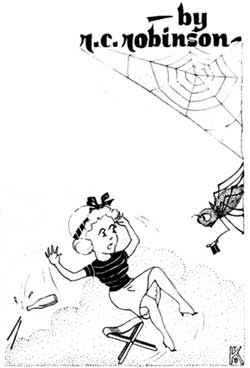
 | ||||||||||
| Intro | Author | Subject | Volume | Volume/Title | NPS | |||||
|
Volume III - Nos. 4 & 5 |
October-November, 1939 | |
|
Picnicking is an ancient form of recreation. Greek men of letters often gathered for an outing in the parks and gardens of that day, each contributing his share of the food for a communal meal and each participating in the program. Being intellectuals, they emphasized such pursuits as philosophical discussions, declamations, drama, music and the arts, but they also engaged in physical sports since they prided themselves on being well rounded individuals --- scholars and athletes. 
Early in the nineteenth century a fashionable group of Londoners organized a Picnic Society. The purpose was to provide members with social entertainment of various kinds, including outings, musicals, dramatic programs, and contests. Each member was required to furnish his share of the entertainment as well as his share of the food. From such patrician beginnings, picnicking has become the common man's most popular form of out-door recreation. The term is applied today to almost every type of out-door pleasure party from a family meal in the back yard to a big all-day-dinner-on-the-ground community gathering. In one section of the country the clam-bake and fish-fry hold the fort of popularity; in another section it is barbecued pig, chicken or calf. Every where the family basket picnic is a favorite out-door recreation. Every where both informal and organized groups go forth to parks and wooded countryside for a meal and a frolic in the out-of-doors. Ask a hundred persons almost anywhere in the country to name their chosen form of out-of-door recreation and a sizable percentage will name picnicking. Question them and it will be learned that the word "picnic" means far more to moat of them than eating a meal in the out-of-doors. To some it includes hiking, climbing, exploring; to others it features a swim in a lake or stream; and to still others it is the gateway to sports and games, to the indulgence of such hobbies as photography, sketching and the study of nature. And there are, of course, those who think of picnicking as simply a chance to get away from home for relaxation in a cool, shady spot surrounded by the peace and beauty of nature. People generally seek recreation in groups. This is particularly true of picnickers. Both young and old, they go to a recreational area as members of a family, as an informal group or as an organization. But recreational interests vary widely within the same group. Planning for picnicking on outlying parks should give full consideration therefore to this range in group interests. Some of the points which require consideration include:
For those engaged in planning a recreational area system it is important to remember that many persons like to pack a lunch and go motoring, either for the sheer pleasure of movement through a pleasant countryside, or to explore a place unknown to them. Conveniently located waysides with picnic stoves and tables, some open space for play, trails for a short hike, a pleasing vista for a few minutes of relaxation, these constitute the principal facility needs of such groups. Some day, when the nation recognizes the recreational value of its streams and quits making sewers of them --- and protects and restores them to their original beauty --- the boat trip, with its picnic lunch as a feature, will become popular. Then there will be a need for waysides along streams wherever spots can be found which are accessible to highways. The picnic has been with us a long time. It now tops the list of favorite out-door activities and is likely to grow in popularity. But to a large extent it is a symbol, a name used to cover a multitude of recreational interests. Like camping, it is a means to an end. This is a fact which should be kept uppermost in the minds of those who plan and develop outdoor recreation systems. Areas other than those selected purely on the basis of scenic values should contain enough level space to permit a more varied program of activities. Open lands interspersed with woods add value by increasing the range of possible use, by offering relief from the monotony of trees which leave no place for play in the sun. People like the sun and it is good for them. Many of them spend their working days cooped up in ofices, stores, warehouses and other dark places. They should be given a chance to enjoy and benefit from the sun's benevolent rays when they escape into the open country for a few hours a week. (click to see an original image of first page of this article) | ||
| <<< Previous | > Contents < | Next >>> | ||
|
http://www.cr.nps.gov/history/online_books/regional_review/vol3-4-5d.htm Date: 04-Jul-2002 | ||||